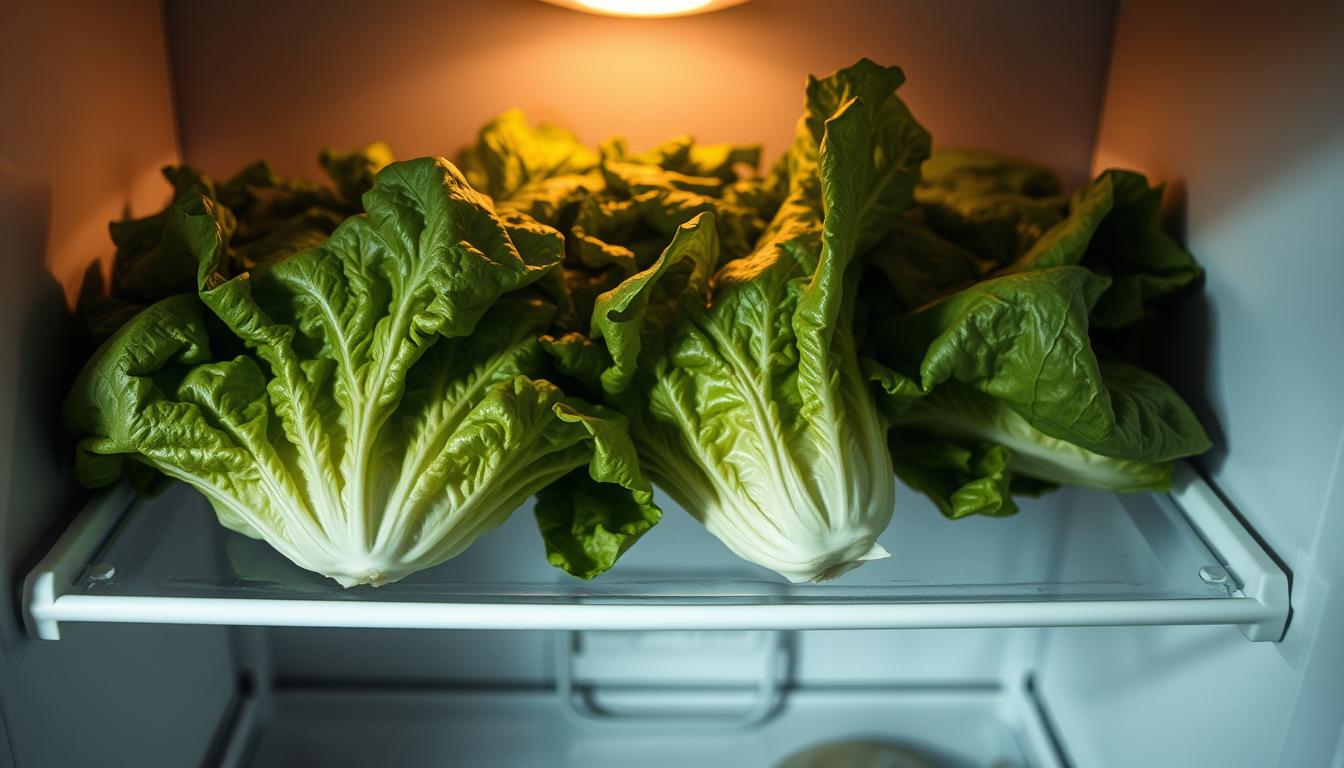Did you know fresh greens lose nearly all their crispness within three days of refrigeration? This happens because leafy vegetables are 96% water. When stored improperly, moisture escapes rapidly, leaving them limp and unappetizing.
Refrigerators create dry environments that pull water from plant cells. As those cells shrink, the structural support for leaves weakens. This dehydration process isn’t spoilage—it’s a natural response to low humidity.
Understanding this difference matters. Wilted greens are safe to eat but lack texture, while slimy or discolored ones signal bacterial growth. Your fridge’s design, though ideal for preserving most foods, accelerates moisture loss in delicate produce.
Key Takeaways
- Leafy greens lose crispness due to dehydration, not always spoilage.
- Refrigerator air conditions speed up moisture loss in water-rich vegetables.
- Shrinking plant cells cause visible wilting without making food unsafe.
- Proper storage methods can slow this natural process significantly.
- Recognizing dehydration versus spoilage prevents unnecessary food waste.
Understanding Lettuce Wilting: Causes and Science
Two invisible forces transform crisp greens into limp leaves: water movement and chemical reactions. Both processes start the moment you store leafy vegetables, but they work in distinct ways. Let’s break down the science behind these changes.

The Role of Osmosis and Water Loss
Plant cells act like tiny water balloons. When exposed to dry fridge air, moisture escapes through cell walls via osmosis. Water naturally flows from areas of high concentration (inside leaves) to low concentration (the surrounding air).
As cells lose liquid, they shrink and collapse. This reduces structural support, making leaves droop. The drier your refrigerator’s environment, the faster this dehydration process occurs.
How Oxidation Affects Leaf Structure
Damaged cells trigger another issue. Enzymes released during bruising or cutting react with oxygen, causing brown edges or spots. This oxidation doesn’t mean your greens have gone bad—it’s purely cosmetic.
Though harmless, these reactions accelerate texture changes. Combined with water loss, they create the soggy appearance of wilted lettuce. Remember: sliminess or foul odors—not limpness—signal spoilage.
Why Lettuce Wilts in the Fridge – Uncovering the Mystery
The secret to keeping leafy vegetables crisp lies in mastering your refrigerator’s hidden climate. Cold air alone doesn’t preserve freshness—it’s the balance of humidity and airflow that determines whether greens stay firm or turn limp.

Environmental Factors in Your Fridge
Your appliance circulates dry air to prevent frost buildup, creating conditions that pull moisture from plant cells. This process accelerates when vegetables sit near vents or in main compartments. Crisper drawers combat this issue through adjustable vents that trap humidity around produce.
Ethylene gas complicates storage further. Fruits like apples release this natural compound, triggering premature ripening in nearby greens. Keep iceberg lettuce and similar varieties in separate containers from ethylene producers to avoid accelerated wilting.
Impact of Temperature and Moisture Levels
Optimal storage occurs at 32-36°F with 90-95% humidity—conditions most crisper drawers provide. Temperature fluctuations above 40°F activate enzymes that break down cell walls faster, while low humidity lets moisture escape through leafy surfaces.
Three factors determine longevity:
- Drawer humidity settings (high for greens, low for fruits)
- Distance from cooling vents
- Sealed containers versus breathable bags
Iceberg varieties last longer than delicate greens due to tighter leaf structures that slow dehydration. Adjust your storage strategy based on these variables to maintain crispness for up to two weeks.
Simple Techniques to Revive Your Wilted Lettuce
Transform floppy leaves back to crisp perfection using kitchen science. Two methods reverse dehydration effectively: strategic water immersion and targeted preparation. Both leverage plant biology to restore texture without special equipment.

Revival With a Cold or Ice Water Bath
Submerge separated leaves in a bowl of chilled water. Add ice cubes to accelerate rehydration—colder temperatures increase water density, forcing moisture into plant cells faster through osmosis. Let greens soak for 20-60 minutes until rigid.
Check progress by bending a leaf. If it snaps instead of drooping, the cellular structure has regained integrity. Use a salad spinner afterward to remove excess liquid without crushing delicate surfaces.
Trimming and Prepping Lettuce for Rehydration
Cut ¼ inch from stems before soaking. Fresh cuts expose vascular tissues, allowing faster water uptake. Remove bruised or slimy areas—these won’t recover and could spoil neighboring leaves.
Gently tear larger leaves instead of slicing. This preserves cell walls better than knife cuts, maintaining structural integrity during revival. Pat dry with paper towels before refrigerating revived greens to prevent renewed wilting.
Effective Lettuce Storage Solutions for Lasting Freshness
Proper storage methods can double your greens’ lifespan while preserving their crunch. The right combination of humidity control and airflow management creates an ideal environment for leafy vegetables.
Utilizing the Crisper Drawer for Optimal Humidity
Set your crisper drawer to high humidity mode (usually marked by a vegetable icon). This setting reduces airflow while trapping moisture around delicate leaves. For best results:
- Line the drawer with paper towels to absorb excess condensation
- Store different lettuce varieties separately to prevent cross-wilting
- Keep ethylene-producing fruits like apples in separate compartments
Drying Techniques Using a Salad Spinner and Paper Towels
After washing, spin greens thoroughly in a salad spinner. Leave them in the spinner basket lined with paper towels – the container’s vents allow airflow while maintaining humidity. For iceberg lettuce or whole heads:
- Wrap in two dry paper towels before placing in plastic bags
- Punch 5-7 holes in storage bags for controlled ventilation
- Replace towels every three days to prevent moisture buildup
This dual approach keeps vegetables crisp for 10-12 days by balancing hydration and airflow. Remember: Dry surfaces prevent bacterial growth, while controlled moisture retention maintains cellular structure.
Home Kitchen Hacks and Expert Tips
Reviving crisp greens requires blending time-tested methods with smart tool choices. You can implement professional techniques at home without specialized equipment—just practical knowledge passed through generations.
Grammie’s Kitchen Hack for Crisp Greens
Fill a large bowl with ice water 30 minutes before serving. Submerge separated leaves, letting osmosis work its magic. The cold temperature forces water back into plant cells, restoring snap to leafy greens.
This method works best with iceberg lettuce and romaine. Pat leaves dry with a paper towel after soaking to prevent diluted dressings. Your salads will rival restaurant quality with minimal effort.
Incorporating Kitchen Tools and Accessories
A salad spinner does double duty—remove moisture after washing and store greens in its ventilated basket. Line containers with dry towels to absorb excess humidity during refrigeration.
For long-term storage, use perforated plastic bags in the crisper drawer. This setup mimics commercial kitchen conditions, keeping produce fresh for 10+ days. Rotate stock weekly to maintain peak texture in your greens.



